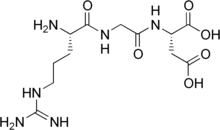
| |
| Names | |
|---|---|
| Systematic IUPAC name
(2S)-2-[[2-[[(2S)-2-amino-5-(diaminomethylideneamino)pentanoyl]amino]acetyl]amino]butanedioic acid | |
| Other names
L-Arginyl-Glycyl-L-Aspartic acid; Arg-Gly-Asp
| |
| Identifiers | |
3D model (JSmol)
|
|
| Abbreviations | RGD Peptide[citation needed] |
| ChEMBL | |
| ChemSpider | |
| MeSH | arginyl-glycyl-aspartic+acid |
PubChem CID
|
|
| UNII | |
CompTox Dashboard (EPA)
|
|
| |
| |
| Properties | |
| C12H22N6O6 | |
| Molar mass | 346.344 g·mol−1 |
| log P | −3.016 |
| Acidity (pKa) | 2.851 |
| Basicity (pKb) | 11.146 |
Except where otherwise noted, data are given for materials in their standard state (at 25 °C [77 °F], 100 kPa).
| |
Arginylglycylaspartic acid (RGD) is the most common peptide motif responsible for cell adhesion to the extracellular matrix (ECM), found in species ranging from Drosophila to humans. Cell adhesion proteins called integrins recognize and bind to this sequence, which is found within many matrix proteins, including fibronectin, fibrinogen, vitronectin, osteopontin, and several other adhesive extracellular matrix proteins.[1] The discovery of RGD and elucidation of how RGD binds to integrins has led to the development of a number of drugs and diagnostics,[2] while the peptide itself is used ubiquitously in bioengineering.[3] Depending on the application and the integrin targeted, RGD can be chemically modified or replaced by a similar peptide which promotes cell adhesion.
- ^ Plow, Edward F.; Haas, Thomas A.; Zhang, Li; Loftus, Joseph; Smith, Jeffrey W. (2000-07-21). "Ligand Binding to Integrins". Journal of Biological Chemistry. 275 (29): 21785–21788. doi:10.1074/jbc.R000003200. ISSN 0021-9258. PMID 10801897.
- ^ Cite error: The named reference
:11was invoked but never defined (see the help page). - ^ Cite error: The named reference
:6was invoked but never defined (see the help page).